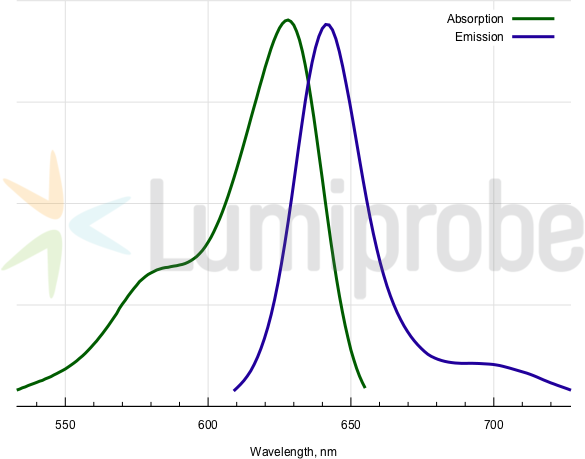BDP® 630/650 alkyne
| Cat. # | Quantity | Price | Lead time | Buy this product |
|---|---|---|---|---|
| A54B0 | 1 mg |
$125
|
in stock | |
| B54B0 | 5 mg |
$260
|
in stock | |
| C54B0 | 10 mg |
$325
|
in stock | |
| D54B0 | 25 mg |
$510
|
in stock | |
| E54B0 | 50 mg |
$895
|
in stock | |
| F54B0 | 100 mg |
$1490
|
in stock |

BDP 630/650 is a red-emitting fluorophore matching the Cyanine5 channel. The dye is useful for fluorescence polarization assays. It is also remarkably photostable.
The terminal alkyne group can be conjugated with various azides by copper-catalyzed click chemistry.
Absorption and emission spectra of BDP 630/650

Recommended protocol
Calculator
Customers also purchased with this product
General properties
| Appearance: | dark colored solid |
| Mass spec M+ increment: | 487.1 |
| Molecular weight: | 487.33 |
| CAS number: | 2006345-38-4 |
| Molecular formula: | C26H20N3BF2O2S |
| Solubility: | good in DMF, DMSO, alcohols |
| Quality control: | NMR 1H, HPLC-MS (95%) |
| Storage conditions: | Storage: 24 months after receival at -20°C in the dark. Transportation: at room temperature for up to 3 weeks. Avoid prolonged exposure to light. Desiccate. |
| MSDS: | Download |
| Product specifications |
Spectral properties
| Excitation/absorption maximum, nm: | 628 |
| ε, L⋅mol−1⋅cm−1: | 97000 |
| Emission maximum, nm: | 642 |
| Fluorescence quantum yield: | 0.91 |
| CF260: | 0.029 |
| CF280: | 0.035 |
Product citations
- Sueldo, D.J.; Godson, A.; Kaschani, F.; Krahn, D.; Kessenbrock, T.; Buscaill, P.; Schofield, C.J.; Kaiser, M.; van der Hoorn, R.A.L. Activity‐based proteomics uncovers suppressed hydrolases and a neo ‐functionalised antibacterial enzyme at the plant–pathogen interface. The New Phytologist, 2023, 241(1), 394-408. doi: 10.1111/nph.18857
BDP® is a trademark of Lumiprobe
This Product is offered and sold for research purposes only. It has not been tested for safety and efficacy in food, drug, medical device, cosmetic, commercial or any other use. Supply does not express or imply authorization to use for any other purpose, including, without limitation, in vitro diagnostic purposes, in the manufacture of food or pharmaceutical products, in medical devices or in cosmetic products.
Short link - lumiprobe.com/sh/p/37
The count of items is incorrect.

























 $
$ 
